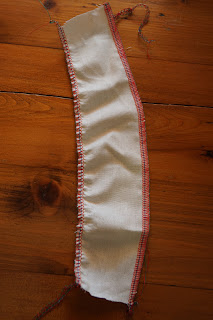You might be wondering what on earth it means when a serger is labelled ‘differential’. Let me explain. This is truly an awesome thing. Being a differential machine, this allows you control of the stitching stability on all types of fabric. When serging a cotton fabric, you will keep the machines differential setting in ‘neutral’.
The two extremes of the differential settings shown on cotton fabric.
Too tight and it pulls in the fabric, too loose and it becomes really wavy.
On a side note – did you know you can change your stitch length the same way you can on your regular sewing machine? Be sure to refer to your manual and search ‘stitch length’ to discover how to do this on your machine.
Sam xox
Sam xox
Disclaimer: Always refer to your own serger/overlocker manual for definitive advice on how to set up, thread and sew with your machine. I do not claim to be an expert on every model and thus am only sharing my personal experiences using two ‘lower end’ models (Toyota3400d and Janome1110dx).




Great series Sam. I caught up with your previous postings. I love my serger. It sat in a corner for months after I bought it and I only fiddled with it periodically. I wanted to combine quilting and serging and found a great book "Serge and Merge" and took a few classes at my LQS. Now I piece with my serger since I've learned about its 1/4 seam allowance notch. I've even mastered mitered corners for borders. Can't wait till you post more. Looking forward to learning more about my serger.
ReplyDeleteI'm so glad you're enjoying the series!!! As a fellow quilter I am amazed that you piece with your serger, I had never thought of that, brilliant! That way you would have perfectly cut 1/4 seams. Mitered borders boarders intimidate me... maybe you could do a tutorial post on those? *hint hint* :-)
DeletePicked my serger up yesterday. Haven't got passed just staring at it at the mo. But have big plans for this weekend!
ReplyDeleteDifferential feed and tension are confusing me at the moment, think I will do as you suggest and just play around with the settings on scrap fabric.
Hope the playing around worked! Remember to try using different colours to make it easier to identify the offending thread :-)
DeleteI am loving your serger series and have been checking your site daily for entries. I bought a serger about a year ago and have used it very little (I think I have been intimidated). But after I read your article I took it out and rethreaded it (I tried once and was unable to). Not only did I get it right but the stitches were right on (I did the 4 color thread as you had suggested). Thank you so much for sharing your knowledge, and for inspiring me!
ReplyDeleteI'm really glad you found the series helpful :-) I'm so thrilled that you were able to get the right tension in your stitches! You will be unstoppable now!
Delete